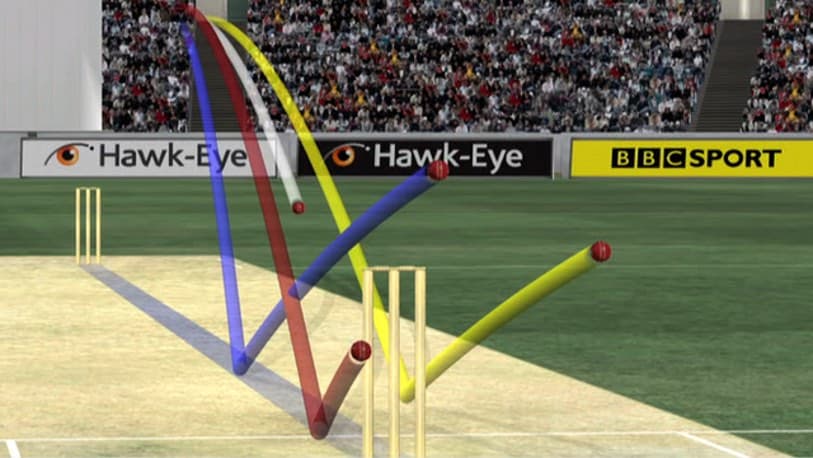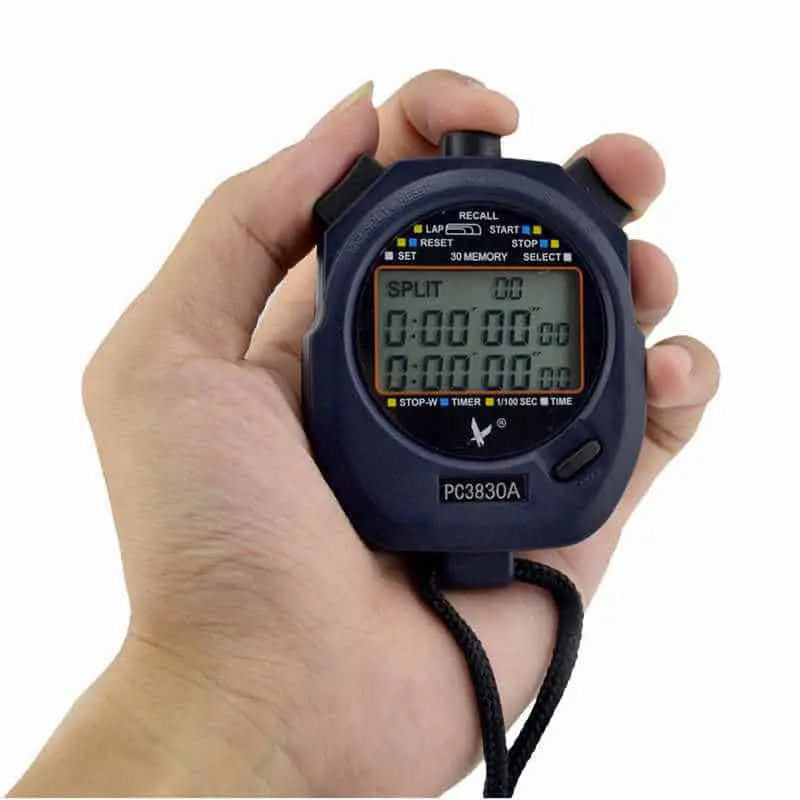Have you ever been watching the cricket on television, seeing the bowlers clocking up speeds of more than 90mph, and wondered how fast your own bowling might be?
You can measure your bowling speed by using a stopwatch to calculate the time the ball takes to reach a batsman and cover the distance of 22 yards between the pitch. Then, divide the distance by time and convert it into miles per hour or kilometers per hour. Alternatively, you can use a Speed Gun.
Each way has its own benefits and downfalls, but each can be a useful tool in better understanding your game and developing your skills to maximize your cricketing ability.
How to Check Your Bowling Speed?
There are a couple of methods of measuring your bowling speed. But, before we figure out how to measure the speed, we need to dive into understand the basics of measuring speed.
Understanding the Basics of Measuring Speed

The way to measure the speed of a ball is relatively straight forward. You simply have to know the distance the ball has traveled and the amount of time it took to do so.
A cricket pitch is 22 yards or 20.12 meters (roughly 20 meters) in length from stump to stump. So, if it takes 0.5 seconds for the ball to travel from one end to the other, then the ball is traveling at 40 meters per second. Once this is converted into miles per hour, this would be just shy of 90mph, which is the speed of the top bowlers in the sport.
So, the basic equation to remember is SPEED = DISTANCE/TIME.
Method 1 – Stop-Watch Method
A relatively inexpensive and simple way to, therefore, measure the speed of your bowling is to ask a friend to use a stopwatch to time how long it takes the ball to travel from your hand to the other end of the wicket.
Most of us may have a stopwatch in-built in our phones. However, if you need to get precise speeds, it is recommended to buy are professional grade stopwatch. These are usually inexpensive to purchase. I’ve found that the PULIVIA Sports Stopwatch [on Amazon] with its soft buttons does a great job in capturing the perfect time.
Just as above, you are then able to calculate the speed of the ball in meters per second.
Once you have calculated a number by using the above formula, the speed that you get is in meters per second. You can then multiply that speed by 2.237 in order to calculate the speed in miles per hour (or 3.6 for kph).
However, it’s important to remember that when you put the distance into your equation when measuring in this way, that the distance is not quite 20 meters long.
The point at which the ball is released by the bowler is about a meter away from the stumps. Therefore, you should make sure to accurately measure the distances involved before making any calculations.
Once you have your data, you will be able to calculate your speed with relative ease. Just make sure that the person working the stopwatch has good hand-eye coordination and reflexes, in order to get the most accurate results using this method.
Method 2 – Using a Speed Gun

If, however, you want a more accurate way to test your speed, you should invest in a speed gun or radar.
These instruments measure the exact speed at which a ball travels between the bowler and the stumps; and don’t require any mathematics on your part!
If you are interested in buying a speed gun, I highly recommend going with this Bushnell Velocity Speed Gun [on Amazon]. It is highly accurate and relatively less expensive as compared to other high-quality devices while maintaining the quality of the speed gun.
They have been used as a means of measuring cricket bowling speeds since the late nineties, having first been developed in a sporting capacity to measure the speed which tennis players served.
In professional grounds, the speed guns are typically positioned high above the sightscreen. However, you can set them up easily at ground level and achieve the same results. They work by sending out a soundwave and when the ball passes through this wave, it is reflected back and detected by the gun.
Beware, however, that if you don’t have software to help differentiate between the ball and any other moving objects that the radar might pick up – you could be measuring the speed of a nearby low flying bird.
Method 3 – Hawk-Eye

Another way that professional players’ bowling speeds are tracked and recorded is through the use of Hawk-Eye. Obviously, this is not recommended for you as an individual, however, we have covered it form the purpose of understanding how speeds are measured in Cricket.
Again, this technology is used in a number of sports other than cricket, including golf, tennis and football. However, the technology was developed specifically for cricket by Dr Paul Hawkins – who had once held his own ambitions to play the game professionally, before realising that he wasn’t as good at cricket as he was at mathematics.
Hawk-Eye uses six cameras placed around a ground to collect data on the movement of the ball. It is incredibly detailed and it’s accurate to within a 5mm margin of error. Therefore, it is one of the most reliable ways to measure the speed of a ball; and also, the most accurate.
Hawkeye was actually introduced for the purposes of adding value to TV analysis. It was first trialed in the coverage of a test between England and Pakistan at Lords in 2001. It quickly became an important tool for commentators and soon the ICC began to explore its use as a means of enforcing the rules and more accurately officiating the game.
That’s why we now see Hawk-Eye being used to assist in umpire’s decision making, as well as tracking stats and presenting data (such as bowling speed) for tv audiences around the world.
Why Measure Your Speed?
There are a number of reasons why a player might want to know how fast they are bowling.
Firstly, and most simply, if you bowl very fast, you’ll be very hard to bat against. If you know your speed and can compare it to others in your team, or even professionals, then you will know the extent to which you need to improve this aspect of your game if you want to take it to the next level.
It is also a good measure of the consistency of your bowling technique. After all, if you bowl three balls an over at 75mph, two at 65mph, and one at 80mph; but don’t know why this is – then you need to find a way to address it. After all, controlling the speed with which you bowl, is just as important as controlling the line and length with which it pitches.
But finally, you might simply want to see how you fare in comparison to the great fast bowlers in cricketing history. If you’ve grown up watching the likes of Brett Lee, Shoaib Akhtar, and Mitchell Johnson, firing it into the batsmen at more than 90mph; then there will no doubt be some curiosity as to how fast that actually is.
How Fast Do Professionals Bowl in Cricket?
Bowlers in International Cricket are known to bowl really fast. We actually covered this topic in great depth in another post in which we not only provide some tips on how to bowl fast, but also compare the speeds of a cricket bowler with a Baseball pitcher! Do check it out!
You’ll often see that professional bowlers achieve speeds of as much as 95mph. However, this is only at the very top level and most professional fast bowlers will be aiming to regularly break the 80mph mark.
The world record for the fastest delivery in a professional cricket match is held by Pakistan’s Shoaib Akhtar. During an ODI between Pakistan and England in 2003, he clocked up a speed of 100.2mph. Meanwhile, the fasted delivery in a Test Match was recorded by Australia’s Mitchell Starc in 2015.
He fell just short of the ‘100 club’, managing to achieve a speed of 99.6mph. Although, even if just shy of breaking into that elusive group of 100mph bowlers, that’s still a speed that even the world’s best batsmen would find uncomfortable to face!
Professional spin bowlers often bowl at around 50-60mph. However, the ability for spin bowlers to suddenly bowl a quicker ball is one of the most dangerous weapons they can hold in their arsenal. For example, Shahid Afridi once managed to bowl at 80mph off his shortened spinners run up!
How Fast Should You Bowl?

It is unlikely that you’ll see anybody get anywhere near such velocity at an amateur level. A very good amateur player might be able to reach speeds of 80mph. However, the average fast bowler at this level will be looking to hit speeds in the region of 60-70mph.
If, after testing your speed, you think that there is room for improvement; there are a number of things you can do to pick up your pace. These range from building up the right muscle groups through work in the gym to maximise your power, through to better understanding the mechanics involved in your action.
Techniques such as using your leading arm (i.e the one not holding the ball) to pull down as you release the ball, can be a simple but effective way of increasing your momentum and thereby increasing your speed.
Is Speed Everything?
Pavel Florin who became world-famous for his less than speedy bowling.
While speed can be an important tool for a fast bowler, it isn’t the case that everybody needs to bowl as fast as they possibly can. A slower bowler – for example an off-spinner – would be looking to regularly hit 40-50mph, which is clearly much less than their quicker team-mates.
However, it is much more important that a spin bowler lands the ball in the right spot; and they must also be able to get enough revolutions on the ball to make it spin. This means that taking a slower run up and focussing on the placement and grip of your fingers must take precedent over slamming it into the batsman as fast as you can.
Even for ‘fast’ bowlers (particularly at the amateur level), it is more important that you consistently hit a good line and length than being able to hit 80mph+ once every couple of overs. Furthermore, a medium-paced bowler who is able to swing the ball around corners is just as useful as a super-fast bowler who bowls it straight up and down the wicket.
So, while it can be useful to measure your speed in order to better understand your game, you shouldn’t allow it to become the be all and end all of your training regimen.


